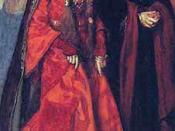Shakespeare shows a range of structures and language throughout King Lear, combining to give the play its overall effect. These devices are particularly useful when exploring the true natures of Lear and Edmond. The use of monologues and soliloquies are of extreme importance as they serve several significant purposes, to not just the effect of the play, but also to the plays themes and story lines. These structures symbolise major turning points in the play, and in some cases the characters state of mind and the revelation of their true nature. The most famous of Shakespeare's soliloquies is Hamlets 'to be or not to be', this form of writing was used frequently. Asides are used to bring us into the play, by producing sympathy for the 'good', and dislike for the 'bad'. This is a typical feature of the drama of the time, used by not just Shakespeare but other play writes such as Marlow.
The popularity of this technique shows a lot about Elizabethan theatre, in comparison to modern, as the expectations of the modern audience in regards to reality is far greater than that of the Elizabethan, who suspended their beliefs whilst inside the theatre. In King Lear the uses of soliloquies, monologues and asides are paired with Shakespeare's exquisite use of language and rhythm to create an great charisma of the characters, especially of Lear and Edmund.
The best line really to describe Lear's true nature is one that is self-analytical 'I am a man more sinned against then sinning.'. It could be said that Lear is a good man, but bad things happen to him as he has too much trust in human kindness. But he could also be described as foolish, as his question to his daughters at the start of the...


